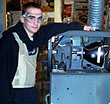|
|
This topic comprises 3 pages: 1 2 3
|
|
Author
|
Topic: Static problems
|
|
|
|
|
|
|
|
|
|
|
John Pytlak
Film God

Posts: 9987
From: Rochester, NY 14650-1922
Registered: Jan 2000
|
 posted 12-12-2002 07:35 AM
posted 12-12-2002 07:35 AM





"Static Cling" was first widely reported in 1995, with prints of "The American President".
Pytlak "Film Notes"
Article to Help with Static Cling on "American President"
Since the introduction of the improved KODAK VISION Color Print films which have a conductive antistatic backing layer, incidents of "static cling" have been greatly reduced, if not completely eliminated.
Optimum humidity for projection rooms is between 50 and 60 percent relative humidity. Accurate, low cost digital humidity gauges are available, and should be used to monitor humidity:
Holmes Humidity Gauge
Radio Shack Gauge 1013
Radio Shack Gauge 1036
With winter heating sometimes reducing the relative humidity to "bone dry" levels below 30% RH, additional moisture sometimes needs to be added to minimize film curl and control static buildup. Most HVAC systems include humidification, but may need to be adjusted for the dry winter months. For localized humidification in the projection room, Kodak recommends evaporative humidifiers that add moisture by blowing the air through a wet media or filter material. Do NOT use humidifiers or vaporizers that actually spray water droplets or mist into the air, as any minerals in the water will dry and deposit themselves as a white salty powder (not good for electronics and optics), and the mist may actually condense on film or electronic components. Steam humidifiers/vaporizers are very expensive to operate, and have limited capacity. Simply leaving buckets of water around is ineffective. Here are some high capacity evaporative humidifiers:
Evaporative Humidifier
Bemis Humidifier
Bemis High Capacity Humidifier
Even though KODAK VISION Color Print film is conductive, any static buildup needs a path to ground to discharge. Platters and projection equipment should be properly grounded. Non-conductive painted or anodized platter surfaces tend to have more static issues than conductive metal ones. Non-conductive platters and plastic rollers can be treated with conductive antistatic products:
Static Guard
ESD Antistats
ACL Antistats
Here's some good technical information on static control:
Static Control Article
"Static Cling" is more likely in the last reel or two of long features, when the film is peeling off the inside of the roll at a very shallow angle, allowing even a tiny amount of static charge to cause the film to stick to itself. Correct platter timing and restraining the outside of the roll are important to reduce the risk of the outside laps shifting, causing "platter fling". Sometimes, changing the winding orientation of the film (soundtrack up vs. soundtrack down) will allow the natural curl of the film to resist the tendency to pull inward.
Treatment of the film itself with an antistatic is not usually necessary for Kodak film, but can be done in severe cases, when the other factors cannot be controlled. Many here on Film-Tech have reported success using FilmGuard.
I am interested in following-up on any chronic instances of "static cling". Let me know the feature title, and magenta edgeprint codes of any prints that are especially prone to "static cling" (e-mail is fine). Provide information on platter type, relative humidity measurement, etc. A small sample of the leader from the affected reels will allow measurement of the processed film conductivity.
| IP: Logged
|
|
|
|
|
|
|
|
|
|
|
|
|
|
|
|
|
|
|
|
|
|
All times are Central (GMT -6:00)
|
This topic comprises 3 pages: 1 2 3
|
Powered by Infopop Corporation
UBB.classicTM
6.3.1.2
The Film-Tech Forums are designed for various members related to the cinema industry to express their opinions, viewpoints and testimonials on various products, services and events based upon speculation, personal knowledge and factual information through use, therefore all views represented here allow no liability upon the publishers of this web site and the owners of said views assume no liability for any ill will resulting from these postings. The posts made here are for educational as well as entertainment purposes and as such anyone viewing this portion of the website must accept these views as statements of the author of that opinion
and agrees to release the authors from any and all liability.
|

 Home
Home
 Products
Products
 Store
Store
 Forum
Forum
 Warehouse
Warehouse
 Contact Us
Contact Us




 Printer-friendly view of this topic
Printer-friendly view of this topic










![[Smile]](smile.gif)
![[Eek!]](eek.gif)
![[thumbsdown]](graemlins/thumbsdown.gif)




